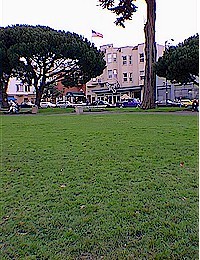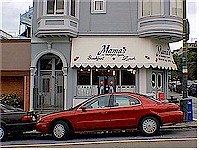|
|
||
| WASHINGTON SQUARE: A LITTLE PIECE OF HEAVEN | ||
| Louis Martin | ||
| NORTH BEACH. It can make your head spin. Stand on the corner of Columbus and Broadway on a Friday night with sex shows in one direction and pasta and pretty people in the other, and you can feel your equilibrium go. | ||
| Yet North Beach is a great love. City Lights, Vesuvio's, Viva's ... how can you hate this place? But for some, it can be too much of a good thing and dizziness sets in. | ||
| But don't worry: there is a calm place in the middle of it all. Washington Square. There you are surrounded by that great heady extravaganza called North Beach but you are no longer in it. Or you are so close to its center that it ceases to spin. | ||
| Washington Square is a moment's rest and a little vision of Heaven on earth. A Hindu heaven, perhaps. For it is the little time out before you reenter life; before you go to Tosca's for a nightcap. |
|
|
| But be aware of this: the square is not a square; it is a trapezoid. That is because of Columbus Street. Columbus Street is why you never know quite where you are in North Beach. It is not till you get out at a map and study it that you realize that the streets of North Beach are not the work of a magician with mirrors; on paper, anyway, they form the conventional neighborhood grid. | ||
| But you'll have to look long and hard at a map to convince yourself of this fact. Columbus is an oblique slash across the grid, causing disorientation almost everywhere. Set foot on Columbus--even catch sight of it--and instantly it's your reference. It may be its size; it's broader than Broadway. Or it may be the power of pasta and people and wine. Whatever the case, it quickly spins you 'round to its point of view. | ||
| But desert Columbus--take Stockton over to Washington Square--and you are quickly back on the grid, except for one small matter: Columbus cuts the corner of the "square," turning it into a large trapezoid and a small triangle. But ignore the triangle and you are at peace in this park. | ||
|
|
Have a seat on a bench with a plaque, the bench donated by some guy desperate to be remembered. Relax and don't give him a thought. Clouds drift overhead, just like they do over Nob Hill, San Francisco's own Mount Olympus. A combination of air and moisture from the sea, the clouds are constantly drifting and changing shape. Around the edge of the park are Monterey pines fashionably trimmed like poodles. Some park barber has gone wild here. | |
| There is a new tune out by the Brit band Prodigy that has made NOW mad. Maybe you know the lyrics. There are only two: | ||
| "Change my pitch up Smack my bitch up." |
||
| NOW says the lyrics incite domestic violence. A band spokesperson says they mean, "doing anything intensely ... going for extreme manic energy." | ||
| That is your park barber. Extreme manic energy. But back to the park. |
|
|
| On your bench, with a little distance between you and the great hubbub of Columbus, you are surrounded by other notable things. On the north side of the park, across its rich green grass, is Saint Peter and Paul's Church. If you look to your left and then to your right, you see that its location must have once been idyllic: in a valley between Russian Hill and Telegraph Hill. | ||
| In fact this used to be pasture land of
a ranch owned by senora Juana Briones, asserts an historical landmark
ignored by people but adored and adorned by pigeons. But back to Saint
Peter and Paul. |
||
| Double spires stretch dramatically upwards, as though trying to snatch a little piece of Heaven. | ||
| Peter and Paul's is of the Salesian order. The order was founded by Don Bosco of Becchi, a man said to have been troubled by a fiery temper in his youth. While passion still runs high in North Beach, it, too, has mostly mastered its temper. North Beach was originally the Latin Quarter of San Francisco, then Little Italy in the 1880s. | ||
| There are still lots of Italians in North Beach--the Italian influence is everywhere--but do not expect a "Little Italy." For better or worse, Italians have long been assimilated into the mainstream of American society. | ||
| Peter and Paul's is a "Romanesque" cathedral with a sculpted, three-dimensional alter that seems infused with light. The dark wood of the church's interior, the sturdy confessionals lining both sides of the sanctuary, and the soft flickering glow of votive candles in alcoves--these all serve to calm the overloaded senses. Who knows? Without this church, North Beach might spin totally out of control on a high caffeine day. | ||
|
|
From your bench in the park you will spot other notable "institutions," most of them offering food and drink. A little walk around the "trapezoid" and the "triangle" and you will find some of San Francisco's most notable: Moose's, Little City; the legendary "Wash Bag," the venerable Fior D'Italia; and not far away, North Beach Restaurant and Rosa Pistola. The Italian-French Baking Company, offering fresh bread warm from the oven, is only a block away on Grant. | |
| You aren't going to go hungry in North Beach; the bounty is enormous and your cup will run over, staining your tie or your blouse. Your car, however, may feel neglected, even unwanted. Guide books suggest a taxi, and that is probably a good idea. | ||
| There is music in North Beach, like jazz at Pearl's. There is a famous book store there where you will be strip-searched these days for stolen goods and still feel thankful to be among the literati of San Francisco. There is entertainment, including one show that came and never went, a rare babbling on that continues to delight. And of course there are the "girls" if you are into that. | ||
| But when you are petered out, the park will always take you back. Unlike other kinds of city space, there is plenty of bench space in the park. Sit at the south side near the new Decaux "pissoir" and look across toward the church. In the middle of the park by some trees you will spot a statue. Washington? No, Franklin. |
|
|
| Why Franklin is there is a little hard to say, though how he got there is well known. He was donated by a rich do-gooder dentist by the name of Cogswell back in the 1880s. Cogswell was a teetotaler, and he got the idea that with enough fountains in the city, San Francisco's thirst for the bottle would dry up. | ||
| Franklin may have been the only statue available for this park. He looks a little like the Buddha in Harlem--out of his element. He stands atop a high pedestal, which may be wise. High, of course, means out of shot and dry in a park. Franklin, the man of practical wisdom, would have appreciated that. | ||
| You remember, of course, that Franklin was a man of letters, a "writer," if you will. According to the books, he was the only one of the founder fathers to sign all four documents that helped create the United States: the Declaration of Independence; the Constitution; the Treaty of Alliance .... Franklin personally composed parts of the Declaration of Independence and the Constitution. Back then those were radical documents; a "howl," you might say. | ||
| He also had his own printing company and came up with the idea of Daylight Savings. You know, squeeze a little more fun into a day. You've heard about Franklin's party days in Paris, no doubt. | ||
| Padrone, Madrone, the statue, it couldn't be more fitting, could it? What is wrong, perhaps, is the name of the square. Or the trapezoid. Or the triangle. But get a grip, drink some grape. In Heaven it doesn't matter. | ||
|
|
|
|








